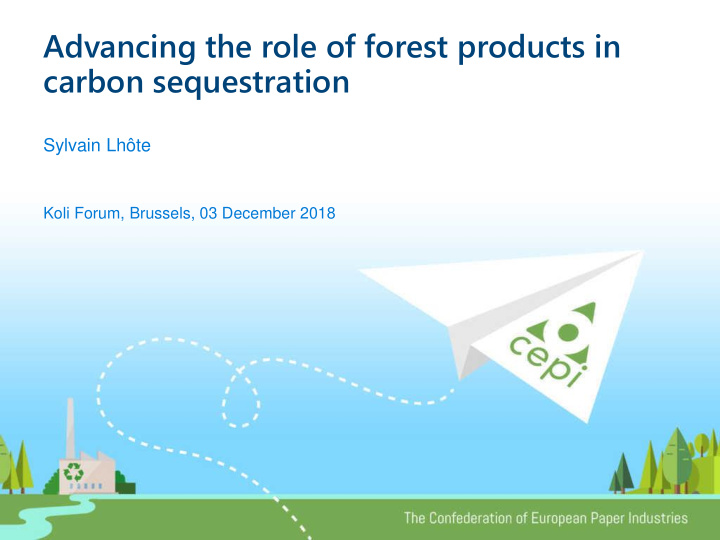



Advancing the role of forest products in carbon sequestration Sylvain Lhôte Koli Forum, Brussels, 03 December 2018
Representing the European forest fibre and paper industry About CEPI • 500 companies in 18 countries • 23% of the World paper production • €75 billion of annual turn -over • 180,000 direct jobs • 1.5 millions people across our value-chain 2
Enhancing industry sustainable growth and innovations in Europe CEPI mission and vision 2011 2013 2015 2017 Long-term Technology Bio-based Investment vision mapping innovation roadmap
What you will remember from today’s presentation… Presentation key point V.C.CO 2 p = -111 MT + 49 MT - 66 MT (pulp & paper industry value chain CO 2 flow profile) 4
The EU forest-based industries today keeps in the loop >220 MT of biogenic carbon Estimated biogenic carbon flow in the Forest-based industry – Pöyry, 2018 Stored Released Captured Harvested 5 5
Brought in perspective, we provide today the most cost- effective “CCS” option Comparison of Carbon Capture & Sequestration (CCS) options Based on Pöyry 2018 CCS Forest plantation • CO 2 removal cost range 80- 250€/T 10- 20€/T Energy Sustainable Forest • Requirements Storage capacity Management Clustered infrastructure Based on positive value Based on CO2 negative cost • Economic s (chain added-value and (or CCU?) wood income) 6
Moving forward, the potential to use C02 exist but remains limited… Example of CCU options in the pulp and paper industry - Pöyry 2018 7
…while BECCS and CCU raise fundamental questions Emerging discussion points on BECCS and Use • Further benefits for society could come from BECCS i.e. CCS applied to Bioenergy in the paper industry or BE Carbon Capture and Use • A technically feasible option, however: - Investment costs vs. value-added for the operator? - Economic viability within changing energy market? (e.g. cost of green electricity vs. cost of biomass for bioenergy vs. CCS energy requirements) - Responsibility and liabilities for building and operating CO 2 transport and storage infrastructures (leaks and use)? • Negative emissions are incompatible with ETS: how to set benchmarks and allocations? • Offsetting someone else’s emissions? What trade -offs and gains? 8
Advancing a low-carbon circular bioeconomy can already step- change industry’s contribution Pulp and paper industry profile and priorities – CEPI 2018 • Reducing our own emissions - 2015 emissions profile +49 MT Greenhouse gases (direct, indirect and transport) - 2050 vision +12 MT • Advancing our products circularity - 2017 recycling level = 72% of all paper-based products - Increased collection and recycling (incl. number of loops) of fibres based products • Mobilising sustainable forest resources - EU sourcing of pulp wood >88% domestic - 93% of owned and managed forests under SFM certification schemes • Scaling-up bioeconomy developments - Valorisation of side streams (lignin, hemicellulose, waste water) and biorefining - Substitution of fossil-based carbon intensive products • Demonstrating our contribution and product carbon loop - Land use models and product environment profile from the tree to the recycled paper 9
Thank you for your attention s.lhote@cepi.org www.cepi.org 10
Recommend
More recommend